10 books by Baker, Chris
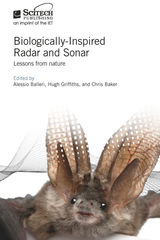
Biologically-Inspired Radar and Sonar
Lessons from nature
Alessio Balleri
The Institution of Engineering and Technology, 2017
Nature presents examples of active sensing which are unique, sophisticated and incredibly fascinating. There are animals that sense the environment actively, for example through echolocation, which have evolved their capabilities over millions of years and that, as a result of evolution, have developed unique in-built sensing mechanisms that are often the envy of synthetic systems.
[more]
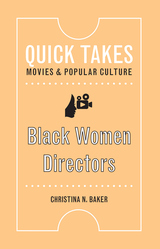
Black Women Directors
Christina N. Baker
Rutgers University Press, 2022
Black women have long recognized the power of film for storytelling. For far too long, however, the cultural and historical narratives about film have not accounted for the contributions of Black women directors. This book remedies this omission by highlighting the trajectory of the culturally significant work of Black women directors in the United States, from the under-examined pioneers of the silent era, to the documentarians who sought to highlight the voices and struggles of Black women, and the contemporary Black women directors in Hollywood. Applying a Black feminist perspective, this book examines the ways that Black women filmmakers have made a way for themselves and their work by resisting the dominant cultural expectations for Black women and for the medium of film, as a whole.
[more]
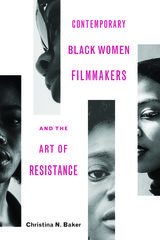
Contemporary Black Women Filmmakers and the Art of Resistance
Christina N. Baker
The Ohio State University Press, 2018
Christina N. Baker’s Contemporary Black Women Filmmakers and the Art of Resistance is the first book-length analysis of representations of Black femaleness in the feature films of Black women filmmakers. These filmmakers resist dominant ideologies about Black womanhood, deliberately and creatively reconstructing meanings of Blackness that draw from their personal experiences and create new symbolic meaning of Black femaleness within mainstream culture. Addressing social issues such as the exploitation of Black women in the entertainment industry, the impact of mass incarceration on Black women, political activism, and violence, these films also engage with personal issues as complex as love, motherhood, and sexual identity. Baker argues that their counter-hegemonic representations have the potential to transform the narratives surrounding Black femaleness. At the intersection of Black feminism and womanism, Baker develops a “womanist artistic standpoint” theory, drawing from the work of Alice Walker, Patricia Hill Collins, bell hooks, Audre Lorde, and Kimberlé Crenshaw.
Analyzing the cultural texts of filmmakers such as Ava DuVernay, Tanya Hamilton, Kasi Lemmons, Gina Prince-Bythewood, and Dee Rees—and including interviews she conducted with three of the filmmakers—Baker emphasizes the importance of applying an intersectional perspective that centers on the shared experiences of Black women and the role of film as a form of artistic expression and a tool of social resistance.
Analyzing the cultural texts of filmmakers such as Ava DuVernay, Tanya Hamilton, Kasi Lemmons, Gina Prince-Bythewood, and Dee Rees—and including interviews she conducted with three of the filmmakers—Baker emphasizes the importance of applying an intersectional perspective that centers on the shared experiences of Black women and the role of film as a form of artistic expression and a tool of social resistance.
[more]

Creator of Nightmares
Henry Fuseli’s Art and Life
Christopher Baker
Reaktion Books, 2024
A critical biography of the eighteenth-century painter.
Henry Fuseli (1741–1825) was one of the eighteenth century’s most provocative and inventive artists. He is best known for his painting The Nightmare, which channeled a new form of gothic imagery for the Romantic age. This engaging study of the artist’s career unveils Fuseli’s complexities, navigating contradictions between literary and painted works, sacred and secular themes, and traditional patronage versus competitive exhibitions. Plotting Fuseli’s trajectory from Zurich to Paris, Rome, and ultimately London, Creator of Nightmares paints an image of Fuseli as an astute marketer and self-proclaimed genius who transformed himself from a priest to an Enlightenment writer, a mercurial force in the art world, and finally a revered teacher.
Henry Fuseli (1741–1825) was one of the eighteenth century’s most provocative and inventive artists. He is best known for his painting The Nightmare, which channeled a new form of gothic imagery for the Romantic age. This engaging study of the artist’s career unveils Fuseli’s complexities, navigating contradictions between literary and painted works, sacred and secular themes, and traditional patronage versus competitive exhibitions. Plotting Fuseli’s trajectory from Zurich to Paris, Rome, and ultimately London, Creator of Nightmares paints an image of Fuseli as an astute marketer and self-proclaimed genius who transformed himself from a priest to an Enlightenment writer, a mercurial force in the art world, and finally a revered teacher.
[more]
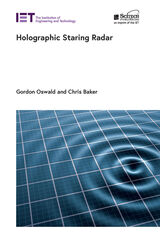
Holographic Staring Radar
Gordon Oswald
The Institution of Engineering and Technology, 2022
The development of radar has been one of the most successful direct applications of physics ever attempted, and then implemented and applied at large scale. Certain watchwords of radar engineering have underpinned many of the developments of the past 80 years and remain potential avenues for improvement. For example, 'Narrow beams are good', 'Fast detection is good', 'Agility is good', and 'Clutter is bad'. All these statements of merit are true. The underlying principles for all these statements are the laws of physics, and they provide support for current radar designs. However, each of these statements is really a design choice, rather than their necessary consequence.
[more]

Medieval Islamic Sectarianism
Christine D. Baker
Arc Humanities Press, 2019
<div>This book asks readers to re-examine their view of the Islamic world and the development of sectarianism in the Middle East by shining a light on the complexity and diversity of early Islamic society. While Sunni Islam eventually became politically and numerically dominant, Sunni and Shiʿi identities took centuries to develop as independent communities. When modern discussions of sectarianism in the Middle East reduce these identities to a 1400-year war between Sunnis and Shiʿis, we create a false narrative.</div>
[more]
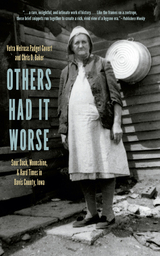
Others Had It Worse
Sour Dock, Moonshine, and Hard Times in Davis County, Iowa
Vetra Melrose Padget Covert and Chris D. Baker
University of Iowa Press, 2013
In 1977, while studying journalism at the University of Iowa, Chris Baker gave his grandmother a notebook and asked her to write about her childhood. Years later, long after her death in 1990, he found the tattered yellow notebook. In twenty-nine handwritten pages, the woman he knew as Grandma Covert had recorded her younger life in rural Iowa between 1920 and 1929. Writing about herself from the ages of four to thirteen, Vetra Covert sent a simple message back to her grandson: “That’s just the way it was. Others had it worse. We got by.”
Captivated by this glimpse of a woman very different from the more formidable grandmother of his memory, Chris Baker reframed Vetra’s journal to create a narrative of her childhood and a window into rural Iowa life in the 1920s. Transcribing her words into nine chapters that illuminate home, family, neighbors, school, and social life, he has composed a collection of candid, whimsical, sometimes ornery stories that will resonate with anyone who has ever tried to decipher the lives found in old letters and photos.
Vetra’s was not a romantic little-house-on-the-prairie childhood. She grew up with seven brothers and sisters (every new baby was “a supprise”) in a dilapidated log cabin near a small town now vanished from the Iowa map. Two rooms up, two rooms down, no plumbing, no electricity, holes in the roof and floor so big “you could of throwed a cat through them.” Her father was a bootlegger-farmer who measured his corn yield in gallons, not bushels, a moonshiner occasionally harassed by federal agents. Although family stories now present him as a quaint old-timer, the reality of living with him was much starker.
In his introduction to Vetra’s recollections, Chris Baker reveals the harsh truths underlying her authentic, uncomplaining account. By honoring her legacy, he discovered a newfound respect for her and for her family’s ability to survive despite the devastating forces of poverty, isolation, and the looming Great Depression. Together he and his grandmother have created an enduring chapter in family history.
[more]
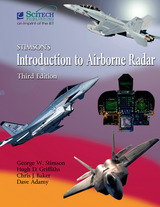
Stimson's Introduction to Airborne Radar
George W. Stimson
The Institution of Engineering and Technology, 2014
Completely modernized, greatly expanded, but retaining all the magic of the 2nd edition, Introduction to Airborne Radar has been brought into the 21st century without losing the hallmarks that made George Stimson's previous editions unique. Every chapter has been updated to reflect the constant transformations in radar technology and end-of-chapter exercises have also been added, improving its employment as a textbook.
[more]
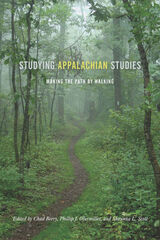
Studying Appalachian Studies
Making the Path by Walking
Edited by Chad Berry, Phillip J. Obermiller, and Shaunna L. Scott
University of Illinois Press, 2015
In this collection, contributors reflect on scholarly, artistic, activist, educational, and practical endeavor known as Appalachian Studies. Following an introduction to the field, the writers discuss how Appalachian Studies illustrates the ways interdisciplinary studies emerge, organize, and institutionalize themselves, and how they engage with intellectual, political, and economic forces both locally and around the world.
Essayists argue for Appalachian Studies' integration with kindred fields like African American studies, women's studies, and Southern studies, and they urge those involved in the field to globalize the perspective of Appalachian Studies; to commit to continued applied, participatory action, and community-based research; to embrace more fully the field's capacity for bringing about social justice; to advocate for a more accurate understanding of Appalachia and its people; and to understand and overcome the obstacles interdisciplinary studies face in the social and institutional construction of knowledge.
Contributors: Chris Baker, Chad Berry, Donald Edward Davis, Amanda Fickey, Chris Green, Erica Abrams Locklear, Phillip J. Obermiller, Douglas Reichert Powell, Michael Samers, Shaunna L. Scott, and Barbara Ellen Smith.
Essayists argue for Appalachian Studies' integration with kindred fields like African American studies, women's studies, and Southern studies, and they urge those involved in the field to globalize the perspective of Appalachian Studies; to commit to continued applied, participatory action, and community-based research; to embrace more fully the field's capacity for bringing about social justice; to advocate for a more accurate understanding of Appalachia and its people; and to understand and overcome the obstacles interdisciplinary studies face in the social and institutional construction of knowledge.
Contributors: Chris Baker, Chad Berry, Donald Edward Davis, Amanda Fickey, Chris Green, Erica Abrams Locklear, Phillip J. Obermiller, Douglas Reichert Powell, Michael Samers, Shaunna L. Scott, and Barbara Ellen Smith.
[more]
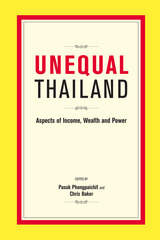
Unequal Thailand
Aspects of Income, Wealth and Power
Edited by Pasuk Phongpaichit and Chris Baker
National University of Singapore Press, 2015
Extreme inequalities in income,wealth and power lie behind Thailand’s political turmoil. What are the sources of this inequality? Why does it persist, or even increase when the economy grows? How can it be addressed?
The contributors to this important study—Thai scholars, reformers and civil servants—shed light on the many dimensions of inequality in Thailand, looking beyond simple income measures to consider land ownership, education, finance, business structures and politics. The contributors propose a series of reforms in taxation, spending and institutional reform that can address growing inequality.
Inequality is among the biggest threats to social stability in Southeast Asia, and this close study of a key Southeast Asian country will be relevant to regional policy-makers, economists and business decision-makers, as well as students of oligarchy and inequality more generally.
The contributors to this important study—Thai scholars, reformers and civil servants—shed light on the many dimensions of inequality in Thailand, looking beyond simple income measures to consider land ownership, education, finance, business structures and politics. The contributors propose a series of reforms in taxation, spending and institutional reform that can address growing inequality.
Inequality is among the biggest threats to social stability in Southeast Asia, and this close study of a key Southeast Asian country will be relevant to regional policy-makers, economists and business decision-makers, as well as students of oligarchy and inequality more generally.
[more]
READERS
Browse our collection.
PUBLISHERS
See BiblioVault's publisher services.
STUDENT SERVICES
Files for college accessibility offices.
UChicago Accessibility Resources
home | accessibility | search | about | contact us
BiblioVault ® 2001 - 2024
The University of Chicago Press









